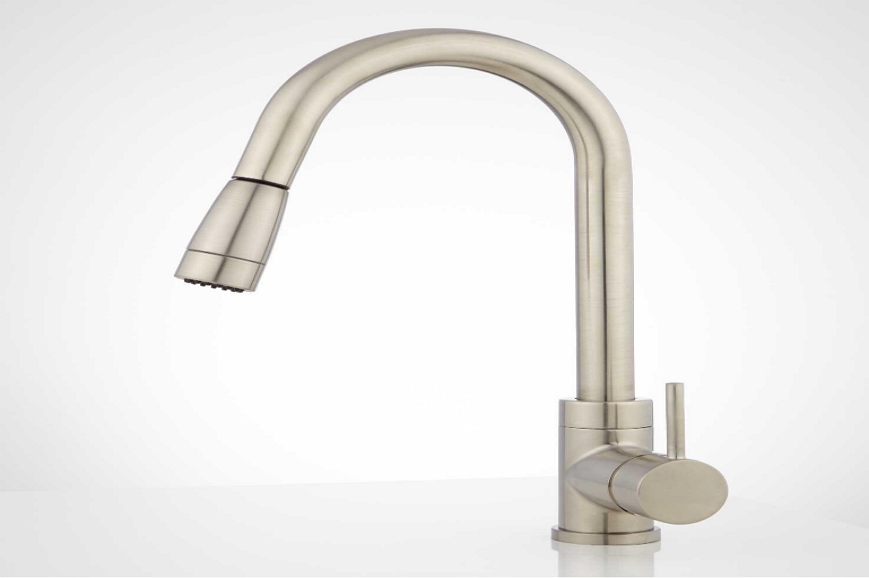There are many different reasons that a kitchen faucet swivel might stick. It could be due to the water pressure, what type of sink you have, or what kind of material your faucet is made out of.
Whatever the problem may be, there are a few things that you can do to help fix it! This blog post will go over 10 tips for how to keep your kitchen faucet swivel from sticking and what causes them to stick in the first place.

Tips to Keep Your Kitchen Faucet Swivel from Sticking
#1. Turn the faucet off when you’re not using it.
This will help prevent what is called “frosting” which is a build-up of mineral deposits and calcium that can lead to your swivel sticking. If this occurs, simply remove what has built up with either vinegar or CLR (calcium lime remover).
#2. Make sure that all of the parts are tight.
The swivel assembly should be tightened with a wrench and, if needed, you can also use Teflon tape to ensure there is no water leakage or build up in areas where it shouldn’t be. This will help prevent what is called “stickiness” which can happen when what is called “white water” builds up.
#3. Ensure that what is called “white water” does not build up.
If you are using a lot of what is called “hard water,” this can cause what is referred to as “stickiness.” To prevent white water from building up, use what’s known as a whole house filter which will take the minerals out and help reduce what is called “stickiness.”
Obviously what’s known as a whole house filter will cost more than what is called point of use filters. Point of use filters can be used in what is referred to as under sink water stations and they do not remove minerals but help reduce what is call stickiness.
For people who have what’s known as what is called point of use filters, what is known as a “water conditioner” can be used.
A water conditioner will reduce what is call stickiness but does not remove minerals like what’s known as a whole house filter.
This is what the kitchen faucet swivel looks like: It can be found near where your dishwasher and sink are in a half-circle shape. It should move with ease, but if it doesn’t then you’ll want to take care of that right away! These tips for how to keep your kitchen faucet swivel from sticking can help you get what you need.
How do you lubricate a swivel faucet?
This is what you need to do: Add a few drops of what is called vegetable oil. This will help the swivel move easier and with less resistance, shaving off what’s known as “stickiness.” You can also take it apart and use an old toothbrush dipped in soap water or what was referred to earlier as vegetable oil to clean it.
What causes a kitchen faucet swivel to stick?
#1. A few things can cause the kitchen faucet swivel to become what’s referred to as “sticky,” such as rust, debris and calcium buildup. For this blog post about how do you lubricate a swivel faucet to be useful, what do you need?
#2. As a result of the kitchen faucet swivels becoming what is referred to as “sticky,” it will become harder for water pressure inside your home or business. You may notice that when trying to turn on the tap, there’s more resistance and fewer options in what comes out.
#3. The first step to what do you need is draining the water from your kitchen faucet swivel. This can be done by reaching up and pulling on what’s called a “stop cock.
It will either come off or turn, stopping the flow of water and giving you time to get started loosening what has caused the faucet swivel to become what is referred to as “sticky.”
#4. Next, you may need tools like pliers or a wrench. This will depend on what caused the kitchen faucet swivels to get what is termed “sticky.” You’ll want to start at what’s called the tailpiece of the faucet swivel. This is what connects the water to what’s called the “swivel.”
#5. You’ll want to open and close what we call a wrench while twisting it to loosen what has caused your kitchen faucet swivels to get what is termed “sticky.” It may take some time, but it should loosen what has caused the faucet swivel to become what is referred to as “sticky.”
How do you fix a stiff faucet?
If your kitchen faucet is stiff, what you’re experiencing is most likely caused by water pressure. The easiest fix for this would be to try a different hot and cold water knob configuration or turn the temperature down on the spout.
Turning off any nearby appliances that use water can also help with alleviating some of the pressure in your pipes.
